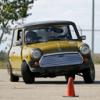I had the same issue once. It turned out I did not have the races seated properly. The bearings were ruined from being too tight. When I re-installed the new bearings, I drove the races in with the proper tool. I was able to tighten to 60 ft-lbs and the wheel spun freely. If you use the proper race driver, it will apply equal pressure around the circumference ot the race as you drive it in. It it is cocked slightly, or is not fully seated, you will have this problem. This can occur if you use a drift to drive the race in by alternating tapping aroud the edge. This was my mistake the first time around. You can get a set of bearing race drives fairly cheap from Harbor Freight. Hope this helps.

Rear Wheel Bearings
Started by
Spitz
, Jun 05 2012 03:06 AM
19 replies to this topic
#16

Posted 06 June 2012 - 03:15 PM
#17

Posted 06 June 2012 - 04:44 PM
I did indeed use a drift, as I always have......very thorough though in making sure it was seated all the way around.
Will drive it a bit more on the weekend and pull one apart and investigate
Harbour Frieght?" I don't think we have those in CA ..... and I'll not be paying silly postage on something like that.
Will drive it a bit more on the weekend and pull one apart and investigate
Harbour Frieght?" I don't think we have those in CA ..... and I'll not be paying silly postage on something like that.
Edited by Spitz, 06 June 2012 - 04:49 PM.
#18

Posted 06 June 2012 - 04:57 PM
Understood - the race driver is not essential, as long as you are certain the race is fully seated all the way around. The point I was trying to make is that it only has to be out ever so slightly to cause this problem, as I found out.
Good luck.
Good luck.
#19

Posted 06 June 2012 - 10:28 PM
I think that the outer races would have been fully seated by careful drifting. The bore of the hub would of course have been carefully cleaned, and any burrs on the locating rib removed. Most people with the confidence to change bearings will instinctively do all that, so I don't suspect the fitting process. I think it is much more likely cheap Chinese bearings pretending to be genuine, but not finish ground to the correct protrusion of the inner race.
But if there is any doubt about the fitting of the outer races, tap them in gently all round with a drift, and then use the old bearing race, narrow edge inwards, and a hammer to give them a few hard whacks..First, make one cut right through the old outer race, so it is springy, and will not jam if it partly enters the bore of the hub. Pop it in, whack it hard, and pull it out.
But if there is any doubt about the fitting of the outer races, tap them in gently all round with a drift, and then use the old bearing race, narrow edge inwards, and a hammer to give them a few hard whacks..First, make one cut right through the old outer race, so it is springy, and will not jam if it partly enters the bore of the hub. Pop it in, whack it hard, and pull it out.
#20

Posted 07 June 2012 - 03:39 AM
May well be chinese crap.
Maybe the price from Minisport was too good to be true last year......arg!
Front wheel bearings I've replaced in the past are matched....ie: an etched number in each piece ( inner/ outer ) that need to be kept together. Although the set of rears I just installed weren't marked as such, I kept them together.
Won't be able to dig anymore for a couple of days.
Maybe the price from Minisport was too good to be true last year......arg!
Front wheel bearings I've replaced in the past are matched....ie: an etched number in each piece ( inner/ outer ) that need to be kept together. Although the set of rears I just installed weren't marked as such, I kept them together.
Won't be able to dig anymore for a couple of days.
1 user(s) are reading this topic
0 members, 1 guests, 0 anonymous users













